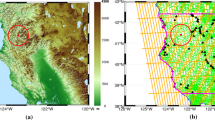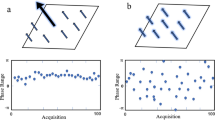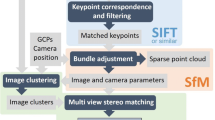Abstract
In the present study, UAV-based monitoring of the Gallenzerkogel landslide (Ybbs, Lower Austria) was carried out by three flight missions. High-resolution digital elevation models (DEMs), orthophotos, and density point clouds were generated from UAV-based aerial photos via structure-from-motion (SfM). According to ground control points (GCPs), an average of 4 cm root mean square error (RMSE) was found for all models. In addition, light detection and ranging (LIDAR) data from 2009, representing the prefailure topography, was utilized as a digital terrain model (DTM) and digital surface model (DSM). First, the DEM of difference (DoD) between the first UAV flight data and the LIDAR-DTM was determined and according to the generated DoD deformation map, an elevation difference of between − 6.6 and 2 m was found. Over the landslide area, a total of 4380.1 m3 of slope material had been eroded, while 297.4 m3 of the material had accumulated within the most active part of the slope. In addition, 688.3 m3 of the total eroded material had belonged to the road destroyed by the landslide. Because of the vegetation surrounding the landslide area, the Multiscale Model-to-Model Cloud Comparison (M3C2) algorithm was then applied to compare the first and second UAV flight data. After eliminating both the distance uncertainty values of higher than 15 cm and the nonsignificant changes, the M3C2 distance obtained was between − 2.5 and 2.5 m. Moreover, the high-resolution orthophoto generated by the third flight allowed visual monitoring of the ongoing control/stabilization work in the area.









Similar content being viewed by others
References
Abellán, A., Calvet, J., Vilaplana, J. M., & Blanchard, J. (2010). Detection and spatial prediction of rockfalls by means of terrestrial laser scanner monitoring. Geomorphology, 119(3–4), 162–171. https://doi.org/10.1016/j.geomorph.2010.03.016.
Ambrosia, V. G., Wegener, S. S., Sullivan, D. V., Buechel, S. W., Dunagan, S. E., Brass, J. A., Stoneburner, J., & Schoenung, S. M. (2003). Demonstrating UAV-acquired real-time thermal data over fires. Photogrammetric Engineering & Remote Sensing, 69(4), 391–402. https://doi.org/10.14358/PERS.69.4.391.
Anders, N., Masselink, R., Keesstra, S., Suomalainen, J. (2013). High-res digital surface modeling using fixed-wing UAV-based photogrammetry. In Proceedings of the Geomorphometry, Nanjing, China, 16–20 October 2013.
Bendea, H., Boccardo, P., Dequal, S., Tonolo, F. G., Marenchino, D., & Piras, M. (2008). Low cost UAV for post-disaster assessment. Proceeding of the The International Archives of the Photogrammetry. Remote Sensing and Spatial Information Sciences, XXXVII(Part B1. Beijing), 1373–1379.
Borradaile, G. J. (2003). Statistics of earth science data: Their distribution in space, time, and orientation (Vol. XXVII, p. 351). Berlin Heidelberg: Springer-Verlag. https://doi.org/10.1007/978-3-662-05223-5.
Brückl, E., Brunner, F. K., & Kraus, K. (2006). Kinematics of a deep-seated landslide derived from photogrammetric, GPS and geophysical data. Engineering Geology, 88(3–4), 149–159. https://doi.org/10.1016/j.enggeo.2006.09.004.
Carvajal, F., Agüera, F., & Pérez, M. (2011). Surveying a landslide in a road embankment using unmanned aerial vehicle photogrammetry. The International Archives of the Photogrammetry, Remote Sensing and Spatial Information Sciences, XXXVIII(Part 1/C22), 201–206.
Clapuyt, F., Vanacker, V., & Oost, K. V. (2016). Reproducibility of UAV-based earth topography reconstructions based on structure-from-motion algorithms. Geomorphology, 260, 4–15. https://doi.org/10.1016/j.geomorph.2015.05.011.
Colomina, I., & Molina, P. (2014). Unmanned aerial systems for photogrammetry and remote sensing: A review. ISPRS Journal of Photogrammetry and Remote Sensing, 92, 79–97. https://doi.org/10.1016/j.isprsjprs.2014.02.013.
Dewitte, O., Jasselette, J. C., Cornet, Y., Van Den Eeckhaut, M., Collignon, A., Poesen, J., & Demoulin, A. (2008). Tracking landslide displacements by multi-temporal DTMs: A combined aerial stereophotogrammetric and LIDAR approach in western Belgium. Engineering Geology, 99(1-2), 11–22. https://doi.org/10.1016/j.enggeo.2008.02.006.
Dunford, R., Michel, K., Gagnage, M., Piégay, H., & Trémelo, M. L. (2009). Potential and constraints of unmanned aerial vehicle technology for the characterization of Mediterranean riparian forest. International Journal of Remote Sensing, 30(19), 4915–4935. https://doi.org/10.1080/01431160903023025.
Eisenbeiss, H. (2004). A mini unmanned aerial vehicle (UAV): System overview and image acquisition. International Archives of Photogrammetry. Remote Sensing and Spatial Information Sciences, 36(5/W1), 7.
Eisenbeiss, H. (2009). UAV photogrammetry. Ph.D. Thesis, Institute of Geodesy and Photogrammetry, ETH Zurich, Zurich, Switzerland, 2009; p. 235.
Eker, R., & Aydın, A. (2014). Assessment of forest road conditions in terms of landslide susceptibility: A case study in Yığılca Forest Directorate (Turkey). Turkish Journal of Agriculture and Forestry, 38, 281–290. https://doi.org/10.3906/tar-1303-12.
Esposito, G., Mastroroceo, G., Salvini, R., Oliveti, M., & Starita, P. (2017). Application of UAV photogrammetry for the multi-temporal estimation of surface extent and volumetric excavation in the Sa Pigada Bianca open-pit mine, Sardinia, Italy. Environment and Earth Science, 76(3), 103. https://doi.org/10.1007/s12665-017-6409-z.
Evaerts, J. (2008). The use of unmanned aerial vehicles (uavs) for remote sensing and mapping. Proceeding of the The International Archives of the Photogrammetry, Remote Sensing and Spatial Information Sciences, XXXVII(Part B1. Beijing), 1187–1191.
Gili, J. A., Corominas, J., & Rius, J. (2000). Using global positioning system techniques in landslide monitoring. Engineering Geology, 55(3), 167–192. https://doi.org/10.1016/S0013-7952(99)00127-1.
Hackney, C., Clayton, A.I. (2015). Unmanned aerial vehicles (UAVs) and their application in geomorphic mapping. In L. Clarke & J. Nields (Eds.), Geomorphological Techniques, British Society for Geomorphology, pp 1–12.
Hsieh, Y.C., Chan, Y., Hu, J. (2016). Digital elevation model differencing and error estimation from multiple sources: A case study from the Meiyuan Shan landslide in Taiwan. Remote Sens., 8, 199.
Hübl, J., Beck, M., Zöchling, M., Moser, M., Kienberger, C., Jenner, A., Forstlechner, D. (2016). Ereignisdokumentation 2015. IAN Report 175, Band 1; Institut für Alpine Naturgefahren, Universität für Bodenkultur – Wien.
Immerzeel, W. W., Kraaijenbrink, P. D. A., Shea, J. M., Shrestha, A. B., Pellicciotti, F., Bierkens, M. F. P., & de Jong, S. M. (2014). High-resolution monitoring of himalayan glacier dynamics using unmanned aerial vehicles. Remote Sensing of Environment, 150, 93–103. https://doi.org/10.1016/j.rse.2014.04.025.
Jaboyedoff, M., Oppikofer, T., Abellan, A., Derron, M. H., Loye, A., Metzger, R., & Pedrazzini, A. (2012). Use of LIDAR in landslide investigations: A review. Natural Hazards, 61(1), 5–28. https://doi.org/10.1007/s11069-010-9634-2.
Lague, D., Brodu, N., & Leroux, J. (2013). Accurate 3D comparison of complex topography with terrestrial laser scanner: Application to the Rangitikei canyon (N-Z). ISPRS Journal of Photogrammetry and Remote Sensing, 82, 10–26. https://doi.org/10.1016/j.isprsjprs.2013.04.009.
Lindner, G., Schraml, K., Mansberger, R., & Hübl, J. (2016). UAV monitoring and documentation of a large landslide. Appl Geomat, 8(1), 1–11. https://doi.org/10.1007/s12518-015-0165-0.
Lucieer, A., de Jong, S. M., & Turner, D. (2014). Mapping landslide displacements using structure from motion (SfM) and image correlation of multi-temporal UAV photography. Progress in Physical Geography, 38(1), 97–116. https://doi.org/10.1177/0309133313515293.
Mateos, R. M., Azañón, J. M., Roldán, F. J., Notti, D., Pérez-Peña, V., Galve, J. P., Pérez-García, J. L., Colomo, C. M., Gómez-López, J. M., Montserrat, O., Devantèry, N., Lamas-Fernández, F., & Fernández-Chacón, F. (2017). The combined use of PSInSAR and UAV photogrammetry techniques for the analysis of the kinematics of a coastal landslide affecting an urban area (SE Spain). Landslides, 14(2), 743–754. https://doi.org/10.1007/s10346-016-0723-5.
Mazzanti, P. (2012). Remote monitoring of deformation. An overview of the seven methods described in previous GINs, Geotechnical News, December 2012, 24–29, ISSN: 0823-650X.
Mazzanti, P. Pezzetti, G. (2013). Traditional and innovative techniques for landslide monitoring: dissertation on design criteria. 19. Tagung für Ingenieurgeologie mit Forum für junge Ingenieurgeologen, pp. 191–197.
Nebiker, S., Annen, A., Scherrer, M., & Oesch, D. (2008). A light weight multispectral sensor for micro UAV—opportunities for very high resolution airborne remote sensing. Proceeding of the The International Archives of the Photogrammetry, Remote Sensing and Spatial Information Sciences, XXXVII(Part B1. Beijing), 1193–1199.
Niethammer, U., Rothmund, S., & Joswig, M. (2009). UAV-based remote sensing of the slow-moving landslide super-Sauze. In J.-P. Malet, A. Remaître, & T. Boogard (Eds.), Proceedings of the International Conference on Landslide Processes: From geomorpholgic mapping to dynamic modelling (pp. 69–74). Strasbourg (2009: CERG Editions.
Peterman, V. (2015). Landslide activity monitoring with the help of unmanned aerial vehicle. The International Archives of the Photogrammetry, Remote Sensing and Spatial Information Sciences, Volume XL-1/W4, 2015 International Conference on Unmanned Aerial Vehicles in Geomatics, 30 Aug–02 Sep 2015, Toronto, Canada, pp. 215–218.
Peternal, T., Kumelj, S., Ostir, K., & Komac, M. (2017). Monitoring the Potoška planina landslide (NW Slovenia) using UAV photogrammetry and tachymetric measurements. Landslides, 14(1), 395–406. https://doi.org/10.1007/s10346-016-0759-6.
Savvaidis, P.D. (2003). Existing landslide monitoring systems and techniques. In Proceedings of the Conference from Stars to Earth and Culture, In honor of the memory of Professor Alexandros Tsioumis. Thessaloniki, Greece, pp. 242–258.
Scaioni, M. (2015). Modern Technologies for Landslide Monitoring and Prediction. Springer Natural Hazards, 2015, 249.
Schweigl, J. (2014). Hollenstein/Ybbs, Gst. Nr. 586, 663, 673. 659/1, 672/1 und 1263/5 (L6180) der KG Großhollenstein, Winkelmayer Karl u. Kordula, Fellner Dietmar, Katastrophenschaden, Erdrutsch und Mure, Wiederherstellung der Forststraße, Geologisches Gutachten (BD1-G-212/022–2014), Amt der Nieder- österreichischen Landesregierung, S. 3–4.
Shervais, K. (2015). Structure from Motion, Introductory Guide. Retrieved July 27, 2016, from https://www.unavco.org/education/resources/educational-resources/lesson/field-geodesy/module-materials/sfm-intro-guide.pdf.
Snavely, N., Seitz, S. M., & Szeliski, R. (2008). Modeling the world from internet photo collections. International Journal of Computer Vision, 80(12), 189–210. https://doi.org/10.1007/s11263-007-0107-3.
Stumpf, A. (2013). Landslide recognition and monitoring with remotely sensed data from passive optical sensors. PhD Thesis, University of Strasbourg.
Sugiura, R., Noguchi, N., & Ishii, K. (2007). Correction of low-altitude thermal images applied to estimating soil water status. Biosystems Engineering, 96(3), 301–313. https://doi.org/10.1016/j.biosystemseng.2006.11.006.
Tanteri, L., Rossi, G., Tofani, V., Vannocci, P., Moretti, S., Casagli, N. (2017). Multitemporal UAV survey for mass movement detection and monitoring. M. Mikoš et al. (eds.), Advancing culture of living with landslides. DOI https://doi.org/10.1007/978-3-319-53498-5_18.
Turner, D., Lucieer, A., & de Jong, S. M. (2015). Time series analysis of landslide dynamics using an unmanned aerial vehicle (UAV). Remote Sensing, 7(2), 1736–1757. https://doi.org/10.3390/rs70201736.
Ullman, S. (1979). The interpretation of structure from motion. Proc. R. Soc. London, Ser. B, 203(1153), 405–426. https://doi.org/10.1098/rspb.1979.0006.
Vrublová, D., Kapica, R., Jiránková, E., & Struś, A. (2015). Documentation of landslides and inaccessible parts of a mine using an unmanned UAV system and methods of digital terrestrial photogrammetry. GeoScience Engineering, 61(3), 8–19.
Wallace, L., Lucieer, A., Watson, C., & Turner, D. (2012). Development of a UAV-LiDAR system with application to forest inventory. Remote Sensing, 4(12), 1519–1543. https://doi.org/10.3390/rs4061519.
Watts, A. C., Ambrosia, V. G., & Hinkley, E. A. (2012). Unmanned aircraft systems in remote sensing and scientific research: Classification and considerations of use. Remote Sensing, 4(12), 1671–1692. https://doi.org/10.3390/rs4061671.
Warrick, J. A., Ritchie, A. C., Adelman, G., Adelman, K., & Limber, P. W. (2017). New techniques to measure cliff change from historical oblique aerial photographs and structure-from-motion photogrammetry. Journal of Coastal Research, 33(1), 39–55.
Wieczorek, G. F., & Snyder, J. B. (2009). Monitoring slope movements. In R. Young & L. Norby (Eds.), Geological monitoring: Boulder (pp. 245–271). Geological Society of America: Colorado.
Xiang, H., & Tian, L. (2011). Development of a low-cost agricultural remote sensing system based on an autonomous unmanned aerial vehicle (UAV). Biosystems Engineering, 108(2), 174–190. https://doi.org/10.1016/j.biosystemseng.2010.11.010.
Zhou, G., Zang, D. (2007). Civil UAV system for earth observation. Proc. IGARSS, pp. 5319–5322.
Acknowledgements
The authors would like to thank the Department of Natural Resources and Life Sciences, Institute of Mountain Risk Engineering (IAN), for the use of their Microcopter OktoXL UAV in the present study. In addition, they wish to thank Friedrich Zott (IAN) and Georg Nagl (IAN) for their contributions in the field work and UAV flights and Gerhard Volk for his supports in the acquisition of LIDAR data.
Funding
This study was funded by The Scientific and Technological Research Council of Turkey (TUBITAK) under the 2214/A-BIDEB Science Fellowship and Grant Program (Application No. 1059B141400900) and by the TUBITAK 2219-Post-Doctoral Research Scholarship (Application No. 1059B191500602).
Author information
Authors and Affiliations
Corresponding author
Rights and permissions
About this article
Cite this article
Eker, R., Aydın, A. & Hübl, J. Unmanned aerial vehicle (UAV)-based monitoring of a landslide: Gallenzerkogel landslide (Ybbs-Lower Austria) case study. Environ Monit Assess 190, 28 (2018). https://doi.org/10.1007/s10661-017-6402-8
Received:
Accepted:
Published:
DOI: https://doi.org/10.1007/s10661-017-6402-8




